Virtual reality teeters on the edge of becoming mainstream, with software development outstripping the hardware and memory storage needed. In this article, a librarian and an art historian discuss the many ways that VR may transform learning and student experiences.

Photo by Jennifer Jones, Georgia State University, CC BY-SA 2.0
Not that long ago students and scholars could access only the libraries and museums available to them on their home campus — or perhaps in their city or region — because only a select few had the credentials to access materials from other institutions or the means to travel to distant places for their research. The Internet changed everything, of course, with the corpus of human knowledge now at everyone's fingertips. Just as hypertext, digital publishing, and other digital media have transformed the ways in which we engage with documents and collections, the technologies surrounding virtual reality (VR) may ultimately transform the ways in which we teach, learn, engage with each other, and experience the world writ large. In a not-too-distant future, as VR technologies advance at a steady pace and become embedded in our lives, we may one day look back with a sense of amazement at students once bound to a physical classroom, campus setting, locale, or even place in time.
VR may be seen as the next logical extension of cyberspace. While scientists and programmers have explored the possibilities of VR since the 1960s,1 last year marked the first time that VR hit the mainstream, when many of us from a broad range of disciplines began to first see its possibilities. With freely available apps, one can journey through our solar system with Titans of Space or experience firsthand what it is like for a young refugee uprooted by war through The Displaced, an immersive video documentary produced by The New York Times, both available for Google Cardboard. One can now experience a Roman gladiator battle with Colosseum VR or take a 360-degree tour of world cities with StreetView VR for the Oculus DK2, and begin to feel like you're actually there.
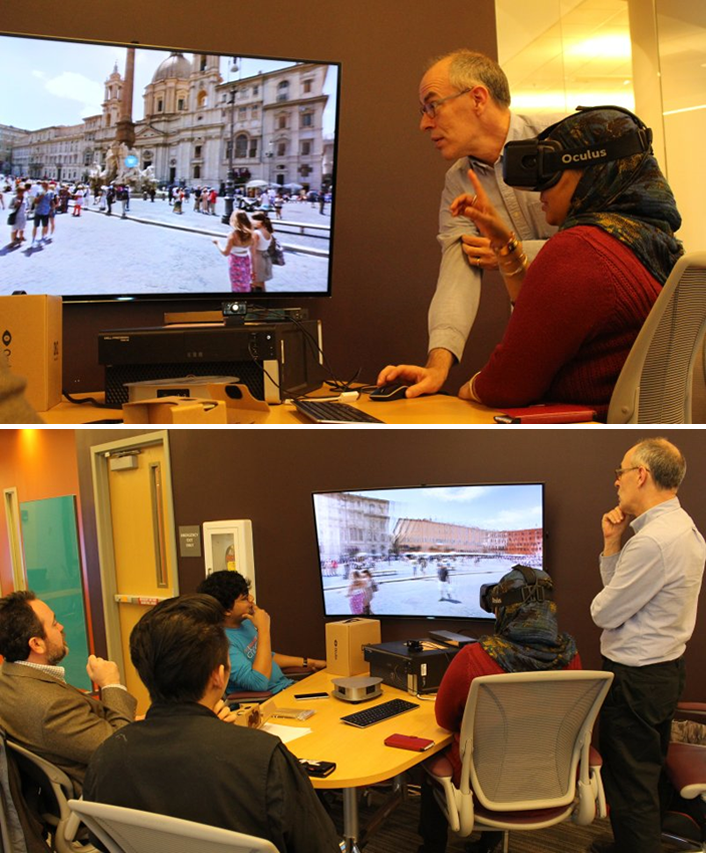
Photos by Jennifer Jones, Georgia State University, CC BY-SA 2.0
Glenn Gunhouse, standing, takes a group of students, faculty, and staff on a virtual field trip of Rome using StreetView VR and the Oculus DK2.
What follows is a conversation between Georgia State University library administrator and coauthor Bryan Sinclair and art history instructor and coauthor Glenn Gunhouse on the possibilities of VR and how it might transform learning as we know it.
Bryan Sinclair: Before we begin, it might be a good idea to clarify exactly what we are talking about. The term "virtual reality" seems to be used to describe a lot of different things these days. What do you mean when you speak of "VR?"
Glenn Gunhouse: I used to apply the term to interactive scenes in which the user's viewpoint could be moved around in a virtual three-dimensional space, and presented as a 2D image on a standard computer screen. I've been making such "virtual spaces" for many years (examples can be found at my Virtual Worlds for Art History Teaching page), but I no longer use the term "virtual reality" to describe those earlier projects. They didn't give users the impression of being physically present inside an actual three-dimensional reality, the way you might imagine it would feel to use the "holodeck" on Star Trek, for example, or to inhabit the "metaverse" of Neal Stephenson's novel Snow Crash. I'd reserve the term "VR" for projects that aim in that direction — virtual spaces that you can feel inside of, and can interact with, that you view with stereoscopic vision and spatialized sound, and in which you can move around freely, looking wherever you please.
Sinclair: The sort of virtual reality that used to be found only in science fiction, or in research labs, but is now becoming available to consumers and educators.
Gunhouse: Right. The kind of virtual reality I am speaking of can be experienced using one of the new head-mounted displays, or HMDs, now coming to market such as the Oculus Rift, HTC VIVE, PlayStation VR, etc.
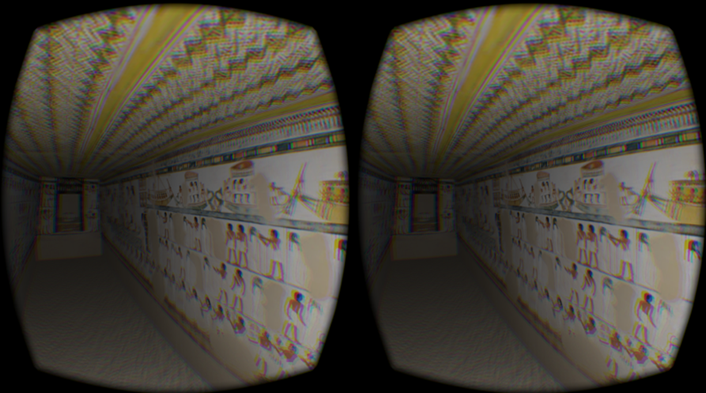
From the Virtual Egyptian Tomb (Tomb of Menna), by Glenn Gunhouse and Melinda Hartwig, Georgia State University, using images provided by the American Research Center in Egypt, with the support of the U.S. Agency for International Development
Sinclair: So, what does VR ultimately offer to students? How will it change the way that you teach in the future?
Gunhouse: What VR offers to my students is an increasingly true-to-life way of visiting places that we otherwise could not visit, either because they are very far away, or because they no longer exist. I'm hopeful that, in the future, I will be able to bring entire classes into a common virtual space with me, so that, for example, I can teach my class on the Roman house inside a virtual Roman house. That's technically possible now, using VR social-networking apps like VRChat. The only thing preventing me from conducting such a virtual field trip today is the lack of a classroom equipped with the necessary hardware.
Sinclair: What sites do you look to as models of the technology?
Gunhouse: I'm very impressed by the various virtual Rome projects — for example, the University of Virginia's Rome Reborn [https://romereborn.squarespace.com/]. Though the city in Rome Reborn can't currently be accessed directly, some of it has been incorporated into Google Earth, so that it can be explored using the same interface as Google Street View. A number of excellent examples can be found at the Zamani Project site developed at the University of Cape Town. None of those examples are yet available as true VR experiences, but it's easy to imagine how they soon could be. One of the most impressive examples that is currently available is an architectural reconstruction of the pre-WWII town of Arnswalde, Germany (now Choszczno, Poland), which can be downloaded and viewed on the Oculus DK2 (Development Kit 2, currently available).
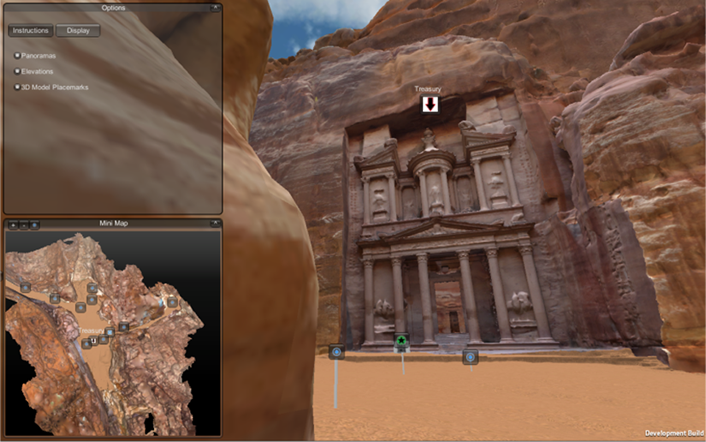
The ancient site at Petra, Jordan, now a web-accessible "virtual world" from the Zamani Project
Sinclair: Tell me more about your own current VR projects.
Gunhouse: I'm in the process of converting my various screen-based virtual spaces to VR-ready versions, in the hope that VR technology like the Oculus Rift will soon become widely available and affordable. I teach courses that deal with city spaces and architecture, and with paintings on the walls of churches. It would help me to have as many such spaces available as possible, so I can send students to visit them. I'm gradually building what I can.
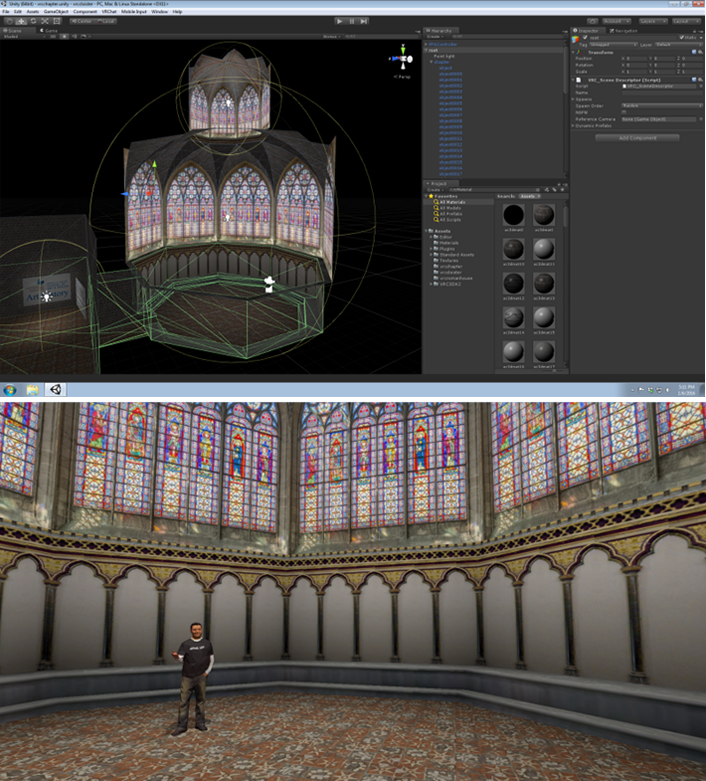
Multiple views and options: (top) Sample model of a gothic chapter house viewed in the Unity workspace, and (bottom) that same virtual space rendered in VRChat, allowing for social interaction with multiple avatars (students and instructor); created by Glenn Gunhouse, Georgia State University.
Sinclair: What basic hardware and software do instructors need? What about their students?
Gunhouse: Developing the sort of virtual-reality products that I'm interested in requires a high-end desktop computer with fast processors and a good GPU. The software required includes a 3D modeler of some sort (for example, 3DS Max, with free download for students and educators), an image processor (for example, Photoshop), and a game engine or scene assembler (for example, Unreal Engine or Unity). The requirements for student machines depend on whether the models are to be viewed on a regular computer screen, or on a head-mounted display like the Oculus Rift. Just about any recent desktop can display my screen-based models without any problems, but the requirements for using the Rift are more demanding and more expensive.
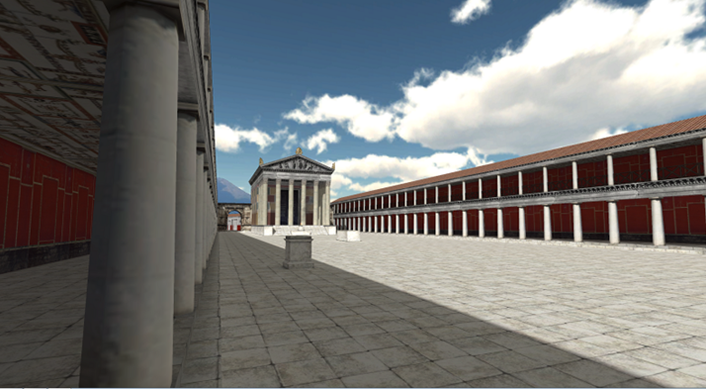
An imaginary forum modeled on the forum of Pompeii in Virtual Roman City (requires Unity Web Player plugin); created by Glenn Gunhouse, Georgia State University
Sinclair: I'm concerned with the potential financial barriers that the Rift may create for learning, for both the student and IT department, at least for now. With the latest Rift, a user will need a fairly powerful PC with sufficient RAM and an advanced GPU and processor or better to power it, according to the Oculus specs.
Gunhouse: It's true that higher-end HMDs like the Oculus Rift or the HTC VIVE, both of which will be launched in 2016, do require more computing power than can be found in most desktops. In fact, NVidia (which manufactures graphics cards) recently estimated that less than one percent of all personal computers in the world right now are capable of running VR applications. The cost of upgrading computer hardware will be significant, I think (and that's on top of the cost of the VR headsets). Such costs will present an economic barrier that I expect will limit the full VR experience to wealthier students, or to those at schools with funds to outfit learning spaces and classrooms designed for VR.
Sinclair: There are already lower cost alternatives, however. As you know, I am a big fan of Google Cardboard and the whole affordable DIY VR movement. (Cardboard is the least expensive and most accessible of VR devices currently on the market that work in tandem with existing smartphones.) With little or no investment, this small corrugated box with a couple of plastic lenses and Velcro fasteners is all one needs to start experiencing VR now. Even news organizations like The New York Times have gotten on board with the potential impact of VR storytelling. They recently included a Cardboard set in the newspaper for all Sunday print subscribers with accompanying content designed specifically for the device.

Photos by Jennifer Jones, Georgia State University, CC BY-SA 2.0
Testing a virtual museum exhibit with Google Cardboard; prototype by Glenn Gunhouse
Gunhouse: I've experimented with Google Cardboard, too, and I've been impressed with how well it works. It does require, though, that you have a suitable smartphone to drive the experience. I know that most of my students already have good smartphones, but many will need to upgrade to models with more advanced graphics performance and CPU power to take advantage of the Cardboard viewer.
Sinclair: We've spoken of technical and financial barriers. What about barriers resulting from disabilities? I know you've been concerned about accessibility.
Gunhouse: Yes, I think it's important to consider accessibility issues as this technology develops, instead of waiting until it's already become established. There has already been a lot of research into the use of virtual reality technology by the physically disabled, since it provides them a means of walking around in spaces that would otherwise be inaccessible to them (see NPR story, "Affordable Virtual Reality Opens New Worlds for People with Disabilities"). My own interest in teaching students about architectural spaces has led me to consider how they might be made accessible not only to the sighted, but also to the blind. Perhaps the most obvious thing that could be done (as is done now for 2D images) is to attach audio labels to the objects in virtual spaces, but more interesting possibilities are opened up by the spatialized-sound technology being developed for the Oculus Rift and other HMDs. Sound-spatializing software, together with head-tracking, make it relatively easy for users to locate sound sources in a 3D virtual space, and thus make it possible for such spaces to become accessible to the blind through their sense of hearing. Sonar-like probes can also be constructed in the virtual world (analogous to accessibility aids in the real world) that should make it possible for the blind to scan virtual architectural spaces and determine the size, location, and distance of their various component parts. I'm just beginning a study of my own to see how such techniques might be applied to the teaching of Roman architecture and city planning.
Sinclair: That's really a fascinating concept. In his book You Are Not a Gadget, author and futurist Jaron Lanier, who did pioneering work with VR in the 1980s, talks optimistically about the potential here to enhance the human experience. While VR has been primarily concerned with creating an immersive visual experience, he imagines a virtual experience incorporating with the other senses as well, involving the whole body, touch, and even smell.2
(Switching gears) I am intrigued by the fact that Facebook purchased Oculus in 2014 for $2 billion. Up until then the company had primarily been of interest to gamers, hobbyists, and a few academics like yourself who were experimenting with the Oculus development kits. Facebook's interest in Oculus suggests to me not only that they believe the barriers we've mentioned might soon be overcome, and that VR might become a mass-market phenomenon, but also that VR is going social, in which case it will no longer be just a solitary experience for a small number of enthusiasts.3
Gunhouse: While I can't speak to Facebook's goals here, it does seem to me that VR is developing in a way that promotes social interactions, rather than social isolation. There are already several VR chat projects underway, but I expect that multiplayer gaming will be more important. The Unity game engine that I use can be used to create networked VR spaces, which is something that I hope to exploit for teaching. The virtual field trips that I imagine for the future would be group experiences.
Sinclair: What about embedding content, text, images, etc. that are already freely available on the web? For example, when we took a virtual tour of Paris in StreetView VR [http://www.streetviewvr.net] app shortly after the terrorist attacks there in November 2015, we were able to view a particular landmark or building and access the Wikipedia article that floated in context within the space. Are there other examples?
Gunhouse: It seems that embedding articles at appropriate locations in VR spaces would be useful, but I don't know of many other examples yet. There are a number of projects that explore new ways of incorporating photographs, videos, and texts into 3D spaces. The VSim project at UCLA is a good example of that approach. One of the most amazing examples that I've seen of the way that information can be incorporated into virtual spaces is a demonstration made by David Finsterwalder using Unreal Engine for the HTC VIVE. It's a 3D scan of an archaeological site (a cave) that can be filled with images representing the objects found within it, drawn from a separate database, and located at the spatial coordinates of their find-spots.
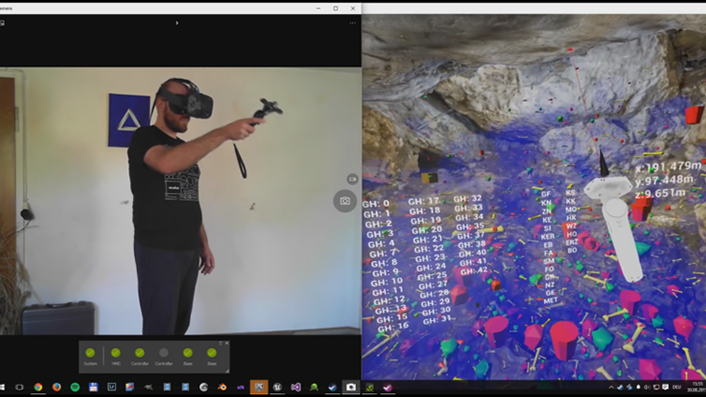
Screenshot from Finsterwalder's demo in YouTube," Archaeological Data visualized with HTC VIVE Development Kit in Unreal Engine 4"; more examples at realities.io
Sinclair: Talk a bit about partnerships with the gaming and hacking communities. A lot of what I've seen is being developed in the Unity game engine.
Gunhouse: I work a lot with Unity myself, although I am working to produce instructional tools, not games per se. By piggybacking on existing gaming software, I've effectively employed a team of professional programmers to develop the tools I need for my own projects, in a way that I could never have afforded to do on my own. I've also benefitted from the help of the game-developer community, which is eager to help with technical issues, coding problems, user experience issues, etc. One of the useful things about Unity is that it can export its "games" to a variety of platforms (Google Cardboard, Oculus Rift, PlayStation VR, Gear VR, Microsoft HoloLens, and several others), though distribution to those platforms is often controlled by the app stores that serve the various brands.
Sinclair: VR seems to bring together students, faculty, developers, and even gamers from a wide array of fields. There is a real interdisciplinary aspect to all this, involving techies and nontechies alike. I'm thinking about ways that VR has inspired new connections at our own university between art and anthropology, history and computer science.
Gunhouse: The production of educational VR requires an interdisciplinary approach, I think. I like to do everything myself, but I'm not as good a coder as other people, or as good an artist, designer, or 3D modeler. To do something really great, I'd have to work with others in a team. The best examples of educational and scholarly virtual reality are the products of large interdisciplinary teams of artists, scholars, programmers, and technicians. As you said, we've developed quite a network of connections here among people with different interests and skill sets, all of whom share a common interest in developing VR applications for teaching and research.
Conclusion
Realizing the promise of VR requires overcoming technical and accessibility obstacles and, with them, significant financial concerns. High-end computers with the latest GPUs and processors can today create amazingly lifelike worlds for devices such as the Oculus Rift, but most of us do not have access to such advanced hardware in our classrooms, labs, or residence halls — at least not presently. At Georgia State University, we have already begun to see a grassroots coming together of computer science students, gamers, hackers, IT professionals, librarians, and digital scholars in art history, English, and anthropology around this promising new technology. We see great potential here in bringing diverse people and disciplines together, expanding our collective frames of reference.
When combined with social media, VR has the potential to connect us with the world and each other in ways never before realized. Our classroom buildings, libraries, and shared academic spaces may someday provide physical grids or open sound stages designed for virtual interaction (think "holodeck"), where groups of students may take guided field trips to remote sites, interface with other cultures, or travel in time. And the instructor will be there as well, acting as the avatar-on-the-side, guiding the conversation, pointing out important concepts and features, and posing questions. Students with physical disabilities or financial disadvantages might have access to places and experiences like never before. Students may also be able to experience things that can only be theorized about, such as journeying into a black hole or flying through a strand of DNA. While VR may be a solitary experience for some, the real promise of VR for educators and academics lies in its capacity for community building and interactive learning.
Notes
- In 1968, computer scientist Ivan Sutherland and student Bob Sproull constructed with is perhaps the first VR head-mounted display (HMD) dubbed the "Sword of Damocles," which was a breakthrough in motion sensing. Objects in space adjusted or remained stationary taking into account the user's point of view and head movements. Later in the 1980s, programmer Jaron Lanier and his company VPL Research advanced the VR experience through their EyePhone, which linked the users' hands to the HMD using DataGloves in order to manipulate the environment. For more on the history of VR, see Steven M. LaValle, Virtual Reality, 2015; and this Scientific American video featuring VR pioneer Kern Perlin at New York University.
- Jaron Lanier, You Are Not a Gadget (New York: Vintage, 2011): 161–63, 184–86.
- Facebook founder and CEO Mark Zuckerberg stated that "Oculus has the chance to create the most social platform ever, and change the way we work, play and communicate" in a press release on the company's acquisition by Facebook.
Bryan Sinclair is associate dean at Georgia State University Library, providing leadership for the library's on-site and virtual research support, research data services, instruction, access services, and technology support. His research interests are in collaborative research and discovery spaces, data services, digital scholarship, and exploring new roles for librarians. See EDUCAUSE profile.
Glenn Gunhouse is a senior lecturer in the Ernest G. Welch School of Art and Design at Georgia State University. He teaches courses on the art of ancient Rome and medieval Europe, with a special emphasis on art in architectural spaces. Since 2001, he has devoted much of his attention to adapting new technologies to the needs of teachers and researchers in the field of art history.
© 2016 Bryan Sinclair and Glenn Gunhouse. This EDUCAUSE Review article is licensed under Creative Commons BY-NC-ND 4.0 International
